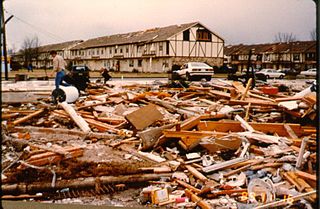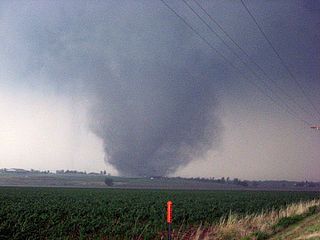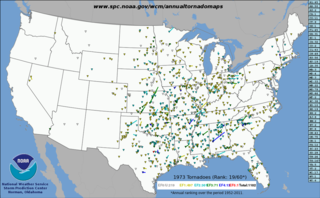These are some notable tornadoes, tornado outbreaks, and tornado outbreak sequences that have occurred around the globe.
- Exact death and injury counts are not possible; especially for large events and events before 1955.
- Prior to 1950 in the United States, only significant tornadoes are listed for the number of tornadoes in outbreaks.
- Due to increasing detection, particularly in the U.S., numbers of counted tornadoes have increased markedly in recent decades although the number of actual tornadoes and counted significant tornadoes has not. In older events, the number of tornadoes officially counted is likely underestimated.

An extremely devastating and deadly tornado outbreak sequence impacted the Midwestern and Northeastern United States at the beginning of June 1953. It included two tornadoes that caused at least 90 deaths each—an F5 tornado occurring in Flint, Michigan, on June 8 and an F4 tornado in Worcester, Massachusetts, on June 9. These tornadoes are among the deadliest in United States history and were caused by the same storm system that moved eastward across the nation.
On April 5–6, 1936, an outbreak of 14 tornadoes struck the Southeastern United States, killing at least 454 people and injuring at least 2,500 others. Over 200 people died in Georgia alone, making it the deadliest disaster ever recorded in the state.

This article lists various tornado records. The most "extreme" tornado in recorded history was the Tri-State tornado, which spread through parts of Missouri, Illinois, and Indiana on March 18, 1925. It is considered an F5 on the Fujita Scale, even though tornadoes were not ranked on any scale at the time. It holds records for longest path length at 219 miles (352 km), longest duration at about 3+1⁄2 hours, and it held the fastest forward speed for a significant tornado at 73 mph (117 km/h) anywhere on Earth until 2021. In addition, it is the deadliest single tornado in United States history with 695 fatalities. It was also the third most costly tornado in history at the time, but has been surpassed by several others when non-normalized. When costs are normalized for wealth and inflation, it still ranks third today.

A deadly series of at least 33 tornadoes hit at least 10 different U.S. states on May 9–11, 1953. Tornadoes appeared daily from Minnesota in the north to Texas in the south. The strongest and deadliest tornado was a powerful F5 tornado that struck Waco, Texas on May 11, causing 114 of the 144 deaths in the outbreak. Alongside the 1902 Goliad tornado, it was the deadliest tornado in Texas history and is the 11th deadliest tornado in U.S. history. The tornado's winds demolished more than 600 houses, 1,000 other structures, and over 2,000 vehicles. 597 injuries occurred, and many survivors had to wait more than 14 hours for rescue. The destruction dispelled a myth that the geography of the region spared Waco from tornadoes, and along with other deadly tornadoes in 1953, the Waco disaster was a catalyst for advances in understanding the link between tornadoes and radar-detected hook echoes. It also generated support for improved civil defense systems, the formation of weather radar networks, and improved communications between stakeholders such as meteorologists, local officials, and the public.

The Daulatpur–Saturia tornado occurred in Manikganj District, Bangladesh on 26 April 1989. There is great uncertainty about the death toll, but official estimates from the World Meteorological Organization indicate that it was devastating and that it killed approximately 1,300 people, which would make it the deadliest tornado in history. In 2022, this tornado's status as the deadliest tornado in history was challenged, claiming it did not kill more than 922 people. The tornado affected the cities of Daulatpur and Saturia the most, moving east through Daulatpur and eventually northeast into Saturia. Previously, the area that the tornado hit had been in a state of drought for six months.

Tornadoes have been recorded on all continents except Antarctica. They are most common in the middle latitudes where conditions are often favorable for convective storm development. The United States has the most tornadoes of any country, as well as the strongest and most violent tornadoes. A large portion of these tornadoes form in an area of the central United States popularly known as Tornado Alley. Canada experiences the second most tornadoes. Ontario and the prairie provinces see the highest frequency. Other areas of the world that have frequent tornadoes include significant portions of Europe, South Africa, Philippines, Bangladesh, parts of Argentina, Uruguay, and southern and southeastern Brazil, northern Mexico, eastern and western Australia, New Zealand, and far eastern Asia.
On April 23–25, 1908, a destructive tornado outbreak affected portions of the Midwestern and Southern United States, including the Great Plains. The outbreak produced at least 31 tornadoes in 13 states, with a total of at least 324 tornado-related deaths. Of these deaths, most were caused by three long-tracked, violent tornadoes—each rated F4 on the Fujita scale and considered to be a tornado family—that occurred on April 24. Most of the deaths were in rural areas, often consisted of African Americans, and consequently may have been undercounted. One of the tornadoes killed 143 people along its path, 73 of them in the U.S. state of Mississippi, making the tornado the third deadliest in Mississippi history, following the 1936 Tupelo F5, with 216 deaths, and the 1840 Natchez tornado, with 317 deaths.
On March 21–22, 1952, a severe tornado outbreak generated eight violent tornadoes across the Southern United States, causing 209 fatalities—50 of which occurred in a single tornado in Arkansas. In addition, this tornado outbreak is the deadliest on record to ever affect the state of Tennessee, with 66 of the fatalities associated with this outbreak occurring in the state; this surpasses the 60 fatalities from a tornado outbreak in 1909, and in terms of fatalities is well ahead of both the 1974 Super Outbreak and the Super Tuesday tornado outbreak, each of which generated 45 and 31 fatalities, respectively. The severe weather event also resulted in the fourth-largest number of tornado fatalities within a 24-hour period since 1950. To date this was considered the most destructive tornado outbreak in Arkansas on record.

A long-lived tornado outbreak sequence affected the Southern Plains, the southeastern and Middle Atlantic region of the United States from May 7–11, 2008. The storm produced 120 confirmed tornadoes starting on May 7 and lasting until late on May 11. The outbreak sequence killed 28 people across several states; 25 were killed by tornadoes. The event occurred less than a week after a deadly tornado outbreak that principally affected the state of Arkansas and killed 7 people.

Tornadoes are fairly uncommon in the US region of New England. Fewer tornadoes are recorded here than anywhere else east of the Rocky Mountains. However, these deadly and destructive storms do occur; on average, about eight tornadoes are reported in the region each year. Almost 200 people have been killed by these storms in recorded history, and two of the ten most destructive tornadoes in US history occurred in this region.

This page documents the tornadoes and tornado outbreaks of 1989, primarily in the United States. Most tornadoes form in the U.S., although some events may take place internationally. Tornado statistics for older years like this often appear significantly lower than modern years due to fewer reports or confirmed tornadoes.

From May 21 to May 26, 2011, one of the largest tornado outbreaks on record affected the Midwestern and Southern regions of the United States. A six-day tornado outbreak sequence, most of the tornadoes developed in a corridor from Lake Superior southwest to central Texas, while isolated tornadoes occurred in other areas. An especially destructive EF5 tornado destroyed one-third of Joplin, Missouri, resulting in 158 deaths and over 1,000 injuries. The Joplin tornado was the deadliest in the United States since April 9, 1947, when an intense tornado killed 181 in the Woodward, Oklahoma, area. Tornado-related deaths also occurred in Arkansas, Kansas, Minnesota, and Oklahoma. Overall, the tornado outbreak resulted in 186 deaths, 8 of those non-tornadic, making it second only to the 2011 Super Outbreak as the deadliest since 1974. It was the second costliest tornado outbreak in United States history behind that same April 2011 outbreak, with insured damage estimated at $4–7 billion.
On December 18–20, 1957, a significant tornado outbreak sequence affected the southern Midwest and the South of the contiguous United States. The outbreak sequence began on the afternoon of December 18, when a low-pressure area approached the southern portions of Missouri and Illinois. Supercells developed and proceeded eastward at horizontal speeds of 40 to 45 miles per hour, yielding what was considered the most severe tornado outbreak in Illinois on record so late in the calendar year. Total losses in the state were estimated to fall within the range of $8–$10 million.
The March 1875 Southeast tornado outbreak was a deadly tornado outbreak that affected portions of the Southern United States from March 19–20, 1875. At least 19 tornadoes were recorded, including seven that were destructive enough to be rated F4 by Thomas P. Grazulis. The worst damage and most of the deaths occurred in Georgia. Most of the damage appears to have been the result of two tornado families that moved along parallel paths 12 to 15 mi apart through parts of Georgia and South Carolina. These families each consisted of numerous long-tracked, intense tornadoes. The deadliest tornado of the outbreak was an estimated F4 that killed 28–42 people in and near Sparta, Georgia, and Edgefield, South Carolina, on March 20. A separate F4 that followed a similar trajectory may have killed as many as 30. In all, this outbreak killed at least 96 people, injured at least 377, and caused at least $650,000 in losses.

This page documents notable tornadoes and tornado outbreaks worldwide in 1973, but mostly features events in the United States. According to tornado researcher Thomas P. Grazulis, documentation of tornadoes outside the United States was historically less exhaustive, owing to the lack of monitors in many nations and, in some cases, to internal political controls on public information. Most countries only recorded tornadoes that produced severe damage or loss of life. Consequently, available documentation in 1973 mainly covered the United States. On average, most recorded tornadoes, including the vast majority of significant—F2 or stronger—tornadoes, form in the U.S., although as many as 500 may take place internationally. Some locations, like Bangladesh, are as prone to violent tornadoes as the U.S., meaning F4 or greater events on the Fujita scale.









